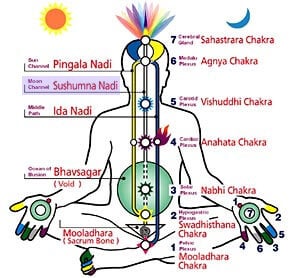Table of Contents
Whenever the term “yoga” is uttered, modern-day mentality immediately turns to skinny girls with stretch-pants and yoga mats flocking around popular yoga centers and Bikram studios. Alas, it’s somewhat of an irony that yoga, a spiritual process that requires a respectful and responsible approach, has become such a status symbol. Even so, yoga has adapted to ever-changing cultures and even now, remains as one of the foremost spiritual practices on Earth.

*This post may contain affiliate links. As an Amazon Associate we earn from qualifying purchases.
What is Kundalini Yoga?
Among the many forms of yoga, Kundalini Yoga is a variation in philosophy and style, structured around both meditation and a physical workout. But rather than concentrate on one or the other, Kundalini Yoga offers both the workout and the meditation while also emphasizing consciousness. The Kundalini Research Institute explains:
“The primary objective [of Kundalini] is to awaken the full potential of human awareness in each individual; that is, recognize our awareness, refine that awareness, and expand that awareness to our unlimited Self. “
So rather than just a physical workout, kundalini yoga allows you to deeply listen while also cultivating inner stillness.
Even the name “Kundalini yoga” is symbolic, Sadhguru explains. According to the yogic culture, the symbol animal for kundalini is the snake, an animal that is the representation of energy that is still not manifested within you. In fact, in Sanskrit, kundalini is an adjective which translates into “circular, annular”. However, it is also used as a noun, when describing something that “forms ringlets” or is “coiled”- a snake. Much like a snake, which becomes visible only when it moves, so too does this energy become apparent in you. Yogic culture states that, when your kundalini is activated, it unleashes a completely different energy level.
Classical hatha yoga literature describes kundalini yoga as a coiled serpent at the base of the spine”, yet again suggesting that sense of untapped potential energy. There are three distinct manifestations of kundalini:
- Para-kundalini, which refers to universal energy
- Prana-kundalini, which refers to the energizing function of the body-mind complex
- Shakti-kundalini, appearing as an intermediary between the two.
But unlike other forms of yoga, Kundalini yoga doesn’t adhere to strict dogmas or rules, but rather allows generations to find personal meaning in the practice. The object of kundalini meditation is simple: to actualize the higher self and help people achieve this state. But rather than identifying itself as THE way, Kundalini is merely one of the tools that individuals may choose when travelling towards personal discovery.
Proper Preparation before Attempting Kundalini Yoga
Experienced yogis utter the word “kundalini” with great reverence because of the high energy that it signifies. Indeed, preparing oneself for the tremendous potential that kundalini energy has is extremely important. Activating the kundalini, experts explain, requires rigorous preparation so that you don’t risk mental and physical imbalance. Yogis note that preparing the body and the mind is an important step when activating the kundalini, so that your system isn’t overwhelmed by the massive amounts of energy that can be awakened.
For many years, Kundalini was kept hidden and passed on from master to worthy disciple. In fact, teaching Kundalini outside of this society was unheard of. Sadhguru explains that classical yogic traditions dictate that there be different types of yoga that are taught to ascetics and people who live in family situations. In such cases, the yoga taught to ascetics would never be taught to those who choose a family life because of the levels of focus and discipline that such forms require.
It was Yogi Bhajan that brought Kundalini Yoga to the west after a deep meditation which granted him visions of a new spirituality in which ancient knowledge and practicality were interconnected. That’s how the 3HO (Healthy, happy, Holy) organization was formed.
Through kundalini energy, kundalini awakening and kundalini rising, it’s possible to claim the birthright that Yogi Bhajan speaks of: the birthright of actualizing the higher self (or the Second Birth, at it is also referred to).
Kundalini Awakening
According to yogis, kundalini is innate to all people and it involves the kundalini energy which is housed, in latent form, at the base of the spine. There are six stages in kundalini awakening:
- Prana flows in Ida or Pingala (Ida and Pingala are the left and right energies that flow alongside the seven chakras)
- Prana then flows in Ida and Pingala
- Prana then flows in Sushumna (the central channel coursing through the seven chakras, also known as the “silver chord”)
- Kundalini energy awakens
- Kundalini energy is lead upwards
- Kundalini rises to Sahasrara (the crown chakra).

Though you can describe Kundalini awakening differently, it’s convenient to do so using the six stages. Either way, once the Kundalini rising begins, individuals experience different signs that are indicative of this experience. They experience a deep, unexplainable yearning for inner development, a feeling as though they don’t fit in, unexplainable inner sensations (of heat, current, light or sound), energy waves flowing or vibrating within, a heightened awareness and sensitivity, special abilities or talents, emotional fluctuations, a deep sense of compassion, and many more.
Connecting to a Higher Self
How is it possible, you would ask, to connect with God (or whichever deity you prefer) via physical exercise, you wonder?
Kundalini Yoga, for instance, and its tradition, depicts God as the same essence as you and me- creative consciousness that generates everything in existence. So, each of us are the expression of the collective energy from which everything else stems. Of course, many of us may not wish to practice kundalini yoga for the sole purpose of achieving a higher self or connecting with divinity. So why would you wish to practice such an ancient ritual?
Of course, Kundalini yoga is a great workout and if you’re not into the intensity of Bikram yoga, you may enjoy Kundalini tremendously. The included meditations will add depth to an already exceptional experience so the health and psychological benefits of the workout should be reason enough. However, kundalini also provides you with a unique connection to your core energy, and this expanded reality to which you will be introduced will generate new and unexpected opportunities.
Things to look forward to are inspiration, clarity of mind, breaking through old and sometimes sorrow-causing mental patterns, a positive and welcoming community.
